University Essay: Mechanical Communication in Cardiac Cell Beating
VerifiedAdded on 2022/12/30
|9
|2922
|44
Essay
AI Summary
This essay critically analyzes the research on mechanical communication in cardiac cell synchronized beating. It begins with an introduction to the topic, including background information and the research question: "How mechanical communication related to cardiac cell synchronized beating of human heart?" The essay then provides a detailed critical analysis of the research, including the results, strengths and weaknesses, uncertainties and limitations, and the author's consideration of other researchers' work. The analysis also examines the justification of the conclusions. The essay explores the implications of the research and suggests future research directions. The study demonstrated mechanical communication between cells directly, providing evidence of long-range interaction that induces alterations in interacting cells. The essay concludes by summarizing the key findings and discussing the importance of mechanical communication in coordinating the activity of cardiac cells, which is essential for the development and function of the heart.
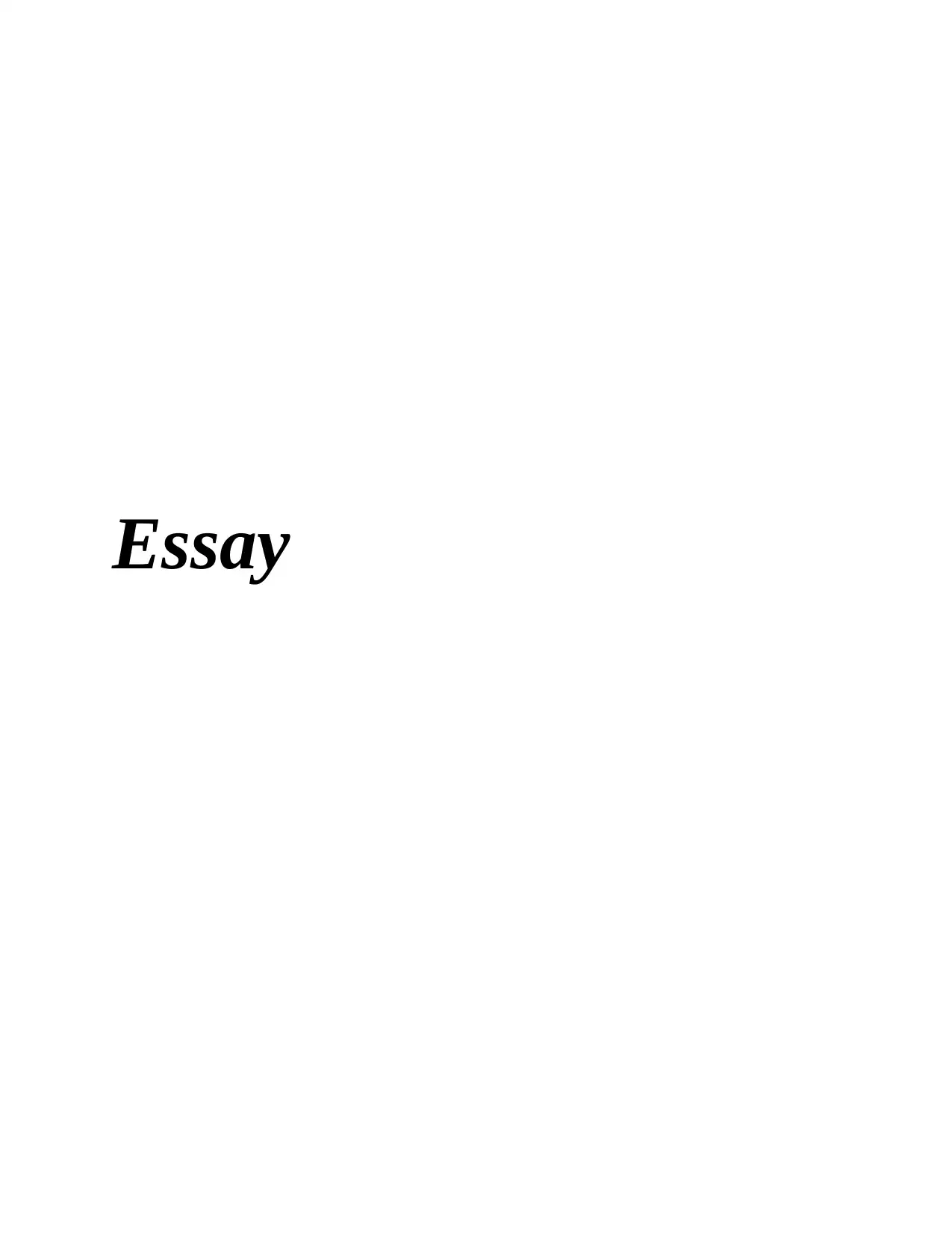
Essay
Paraphrase This Document
Need a fresh take? Get an instant paraphrase of this document with our AI Paraphraser
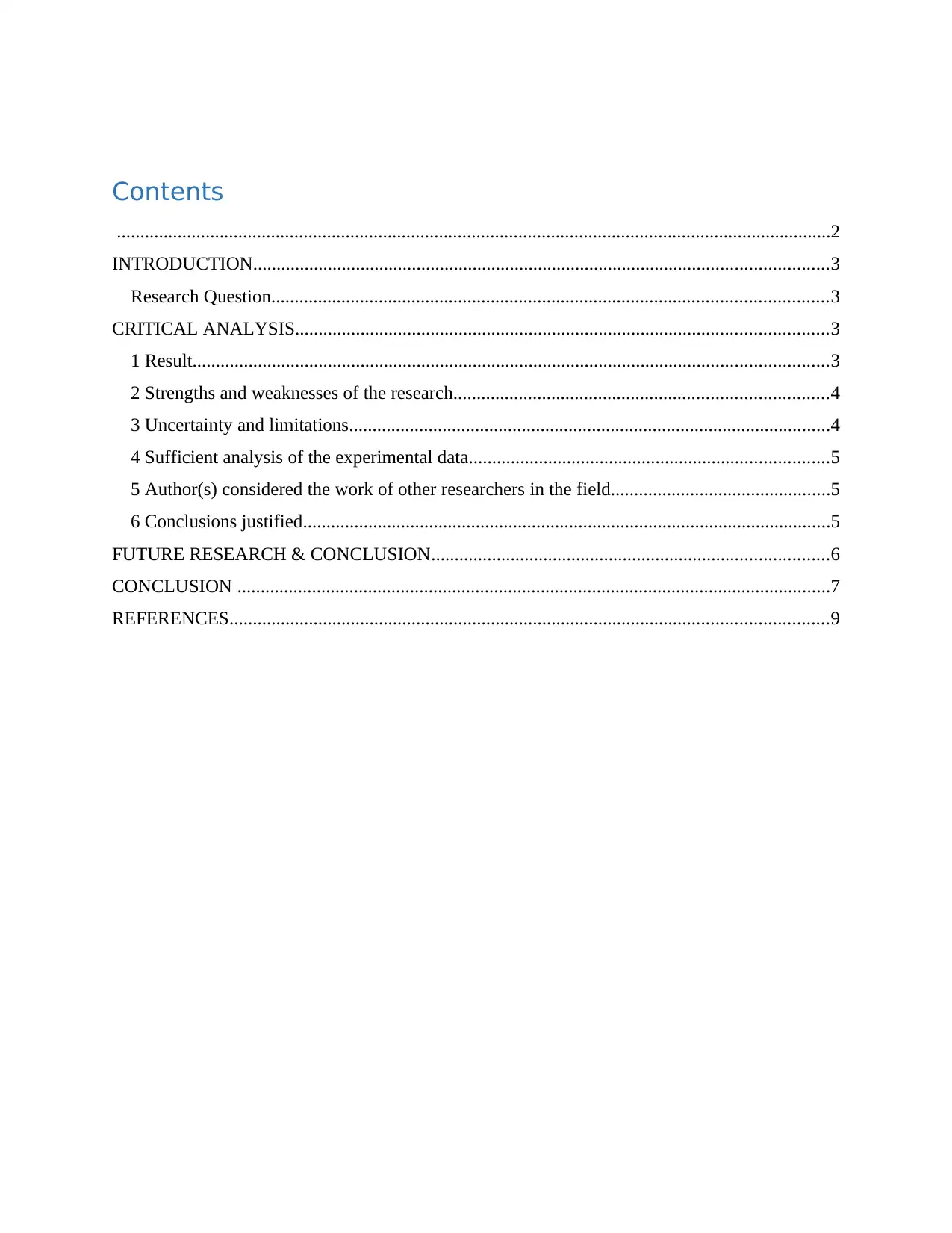
Contents
.........................................................................................................................................................2
INTRODUCTION...........................................................................................................................3
Research Question.......................................................................................................................3
CRITICAL ANALYSIS..................................................................................................................3
1 Result........................................................................................................................................3
2 Strengths and weaknesses of the research................................................................................4
3 Uncertainty and limitations.......................................................................................................4
4 Sufficient analysis of the experimental data.............................................................................5
5 Author(s) considered the work of other researchers in the field...............................................5
6 Conclusions justified.................................................................................................................5
FUTURE RESEARCH & CONCLUSION.....................................................................................6
CONCLUSION ...............................................................................................................................7
REFERENCES................................................................................................................................9
.........................................................................................................................................................2
INTRODUCTION...........................................................................................................................3
Research Question.......................................................................................................................3
CRITICAL ANALYSIS..................................................................................................................3
1 Result........................................................................................................................................3
2 Strengths and weaknesses of the research................................................................................4
3 Uncertainty and limitations.......................................................................................................4
4 Sufficient analysis of the experimental data.............................................................................5
5 Author(s) considered the work of other researchers in the field...............................................5
6 Conclusions justified.................................................................................................................5
FUTURE RESEARCH & CONCLUSION.....................................................................................6
CONCLUSION ...............................................................................................................................7
REFERENCES................................................................................................................................9
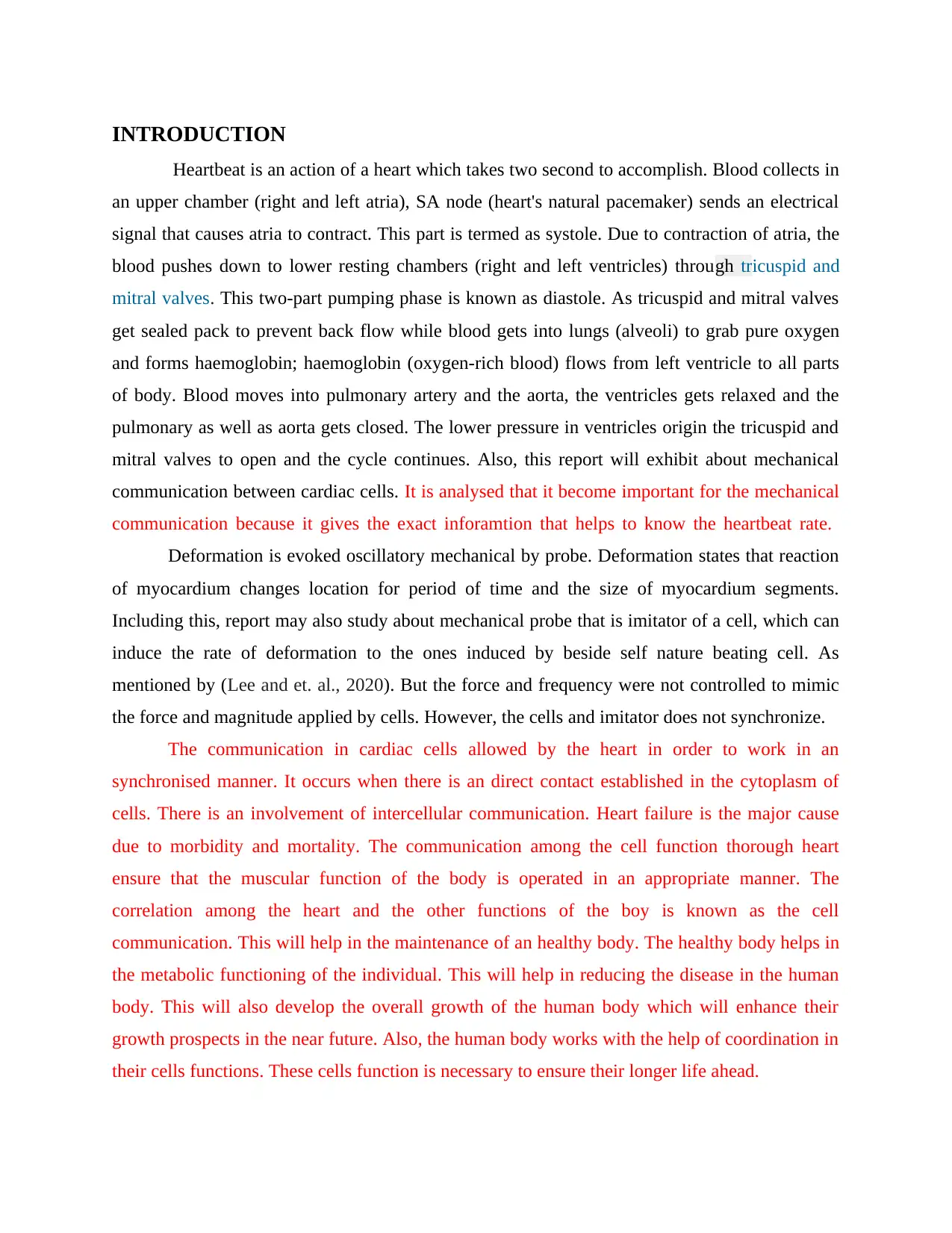
INTRODUCTION
Heartbeat is an action of a heart which takes two second to accomplish. Blood collects in
an upper chamber (right and left atria), SA node (heart's natural pacemaker) sends an electrical
signal that causes atria to contract. This part is termed as systole. Due to contraction of atria, the
blood pushes down to lower resting chambers (right and left ventricles) through tricuspid and
mitral valves. This two-part pumping phase is known as diastole. As tricuspid and mitral valves
get sealed pack to prevent back flow while blood gets into lungs (alveoli) to grab pure oxygen
and forms haemoglobin; haemoglobin (oxygen-rich blood) flows from left ventricle to all parts
of body. Blood moves into pulmonary artery and the aorta, the ventricles gets relaxed and the
pulmonary as well as aorta gets closed. The lower pressure in ventricles origin the tricuspid and
mitral valves to open and the cycle continues. Also, this report will exhibit about mechanical
communication between cardiac cells. It is analysed that it become important for the mechanical
communication because it gives the exact inforamtion that helps to know the heartbeat rate.
Deformation is evoked oscillatory mechanical by probe. Deformation states that reaction
of myocardium changes location for period of time and the size of myocardium segments.
Including this, report may also study about mechanical probe that is imitator of a cell, which can
induce the rate of deformation to the ones induced by beside self nature beating cell. As
mentioned by (Lee and et. al., 2020). But the force and frequency were not controlled to mimic
the force and magnitude applied by cells. However, the cells and imitator does not synchronize.
The communication in cardiac cells allowed by the heart in order to work in an
synchronised manner. It occurs when there is an direct contact established in the cytoplasm of
cells. There is an involvement of intercellular communication. Heart failure is the major cause
due to morbidity and mortality. The communication among the cell function thorough heart
ensure that the muscular function of the body is operated in an appropriate manner. The
correlation among the heart and the other functions of the boy is known as the cell
communication. This will help in the maintenance of an healthy body. The healthy body helps in
the metabolic functioning of the individual. This will help in reducing the disease in the human
body. This will also develop the overall growth of the human body which will enhance their
growth prospects in the near future. Also, the human body works with the help of coordination in
their cells functions. These cells function is necessary to ensure their longer life ahead.
Heartbeat is an action of a heart which takes two second to accomplish. Blood collects in
an upper chamber (right and left atria), SA node (heart's natural pacemaker) sends an electrical
signal that causes atria to contract. This part is termed as systole. Due to contraction of atria, the
blood pushes down to lower resting chambers (right and left ventricles) through tricuspid and
mitral valves. This two-part pumping phase is known as diastole. As tricuspid and mitral valves
get sealed pack to prevent back flow while blood gets into lungs (alveoli) to grab pure oxygen
and forms haemoglobin; haemoglobin (oxygen-rich blood) flows from left ventricle to all parts
of body. Blood moves into pulmonary artery and the aorta, the ventricles gets relaxed and the
pulmonary as well as aorta gets closed. The lower pressure in ventricles origin the tricuspid and
mitral valves to open and the cycle continues. Also, this report will exhibit about mechanical
communication between cardiac cells. It is analysed that it become important for the mechanical
communication because it gives the exact inforamtion that helps to know the heartbeat rate.
Deformation is evoked oscillatory mechanical by probe. Deformation states that reaction
of myocardium changes location for period of time and the size of myocardium segments.
Including this, report may also study about mechanical probe that is imitator of a cell, which can
induce the rate of deformation to the ones induced by beside self nature beating cell. As
mentioned by (Lee and et. al., 2020). But the force and frequency were not controlled to mimic
the force and magnitude applied by cells. However, the cells and imitator does not synchronize.
The communication in cardiac cells allowed by the heart in order to work in an
synchronised manner. It occurs when there is an direct contact established in the cytoplasm of
cells. There is an involvement of intercellular communication. Heart failure is the major cause
due to morbidity and mortality. The communication among the cell function thorough heart
ensure that the muscular function of the body is operated in an appropriate manner. The
correlation among the heart and the other functions of the boy is known as the cell
communication. This will help in the maintenance of an healthy body. The healthy body helps in
the metabolic functioning of the individual. This will help in reducing the disease in the human
body. This will also develop the overall growth of the human body which will enhance their
growth prospects in the near future. Also, the human body works with the help of coordination in
their cells functions. These cells function is necessary to ensure their longer life ahead.
⊘ This is a preview!⊘
Do you want full access?
Subscribe today to unlock all pages.

Trusted by 1+ million students worldwide
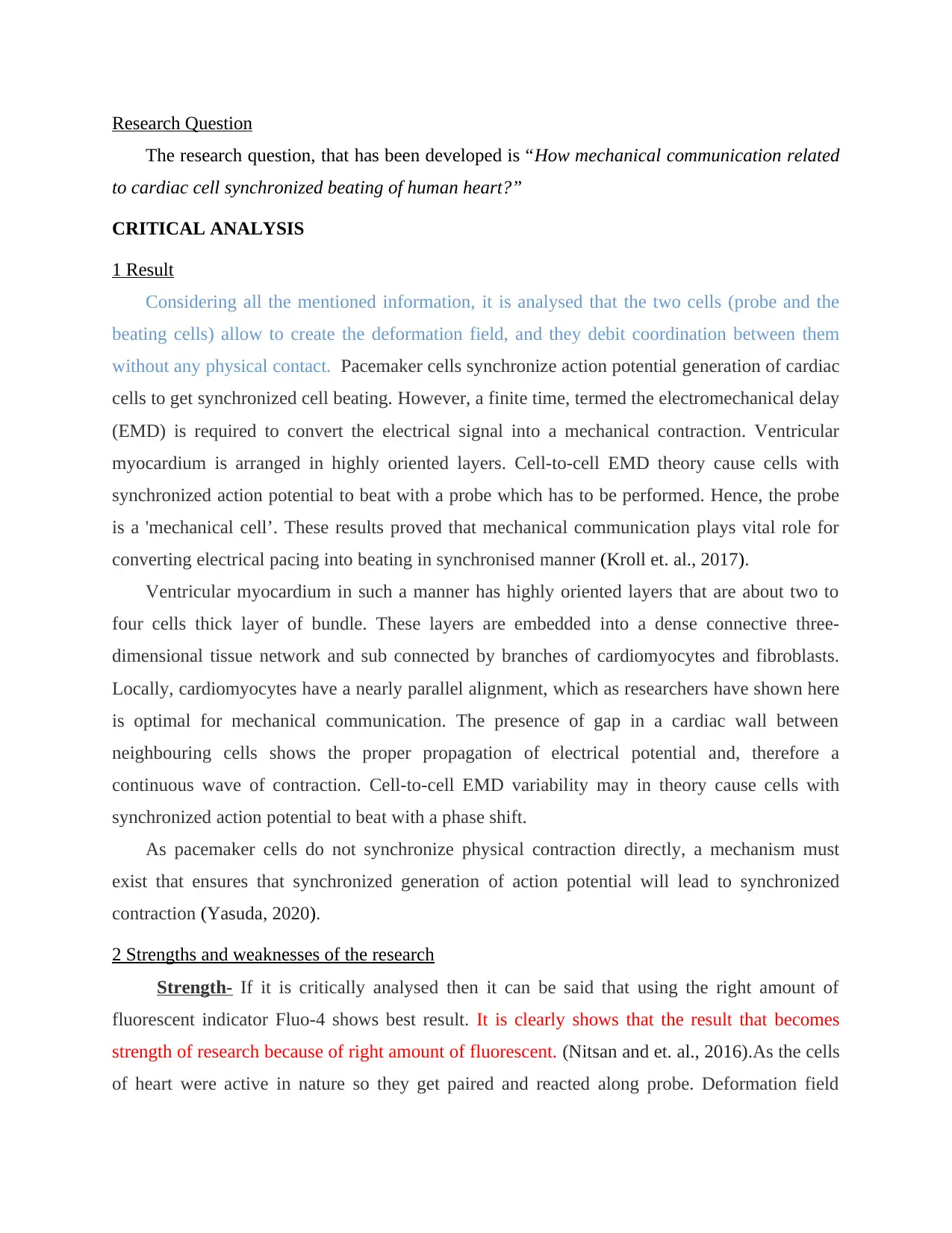
Research Question
The research question, that has been developed is “How mechanical communication related
to cardiac cell synchronized beating of human heart?”
CRITICAL ANALYSIS
1 Result
Considering all the mentioned information, it is analysed that the two cells (probe and the
beating cells) allow to create the deformation field, and they debit coordination between them
without any physical contact. Pacemaker cells synchronize action potential generation of cardiac
cells to get synchronized cell beating. However, a finite time, termed the electromechanical delay
(EMD) is required to convert the electrical signal into a mechanical contraction. Ventricular
myocardium is arranged in highly oriented layers. Cell-to-cell EMD theory cause cells with
synchronized action potential to beat with a probe which has to be performed. Hence, the probe
is a 'mechanical cell’. These results proved that mechanical communication plays vital role for
converting electrical pacing into beating in synchronised manner (Kroll et. al., 2017).
Ventricular myocardium in such a manner has highly oriented layers that are about two to
four cells thick layer of bundle. These layers are embedded into a dense connective three-
dimensional tissue network and sub connected by branches of cardiomyocytes and fibroblasts.
Locally, cardiomyocytes have a nearly parallel alignment, which as researchers have shown here
is optimal for mechanical communication. The presence of gap in a cardiac wall between
neighbouring cells shows the proper propagation of electrical potential and, therefore a
continuous wave of contraction. Cell-to-cell EMD variability may in theory cause cells with
synchronized action potential to beat with a phase shift.
As pacemaker cells do not synchronize physical contraction directly, a mechanism must
exist that ensures that synchronized generation of action potential will lead to synchronized
contraction (Yasuda, 2020).
2 Strengths and weaknesses of the research
Strength- If it is critically analysed then it can be said that using the right amount of
fluorescent indicator Fluo-4 shows best result. It is clearly shows that the result that becomes
strength of research because of right amount of fluorescent. (Nitsan and et. al., 2016).As the cells
of heart were active in nature so they get paired and reacted along probe. Deformation field
The research question, that has been developed is “How mechanical communication related
to cardiac cell synchronized beating of human heart?”
CRITICAL ANALYSIS
1 Result
Considering all the mentioned information, it is analysed that the two cells (probe and the
beating cells) allow to create the deformation field, and they debit coordination between them
without any physical contact. Pacemaker cells synchronize action potential generation of cardiac
cells to get synchronized cell beating. However, a finite time, termed the electromechanical delay
(EMD) is required to convert the electrical signal into a mechanical contraction. Ventricular
myocardium is arranged in highly oriented layers. Cell-to-cell EMD theory cause cells with
synchronized action potential to beat with a probe which has to be performed. Hence, the probe
is a 'mechanical cell’. These results proved that mechanical communication plays vital role for
converting electrical pacing into beating in synchronised manner (Kroll et. al., 2017).
Ventricular myocardium in such a manner has highly oriented layers that are about two to
four cells thick layer of bundle. These layers are embedded into a dense connective three-
dimensional tissue network and sub connected by branches of cardiomyocytes and fibroblasts.
Locally, cardiomyocytes have a nearly parallel alignment, which as researchers have shown here
is optimal for mechanical communication. The presence of gap in a cardiac wall between
neighbouring cells shows the proper propagation of electrical potential and, therefore a
continuous wave of contraction. Cell-to-cell EMD variability may in theory cause cells with
synchronized action potential to beat with a phase shift.
As pacemaker cells do not synchronize physical contraction directly, a mechanism must
exist that ensures that synchronized generation of action potential will lead to synchronized
contraction (Yasuda, 2020).
2 Strengths and weaknesses of the research
Strength- If it is critically analysed then it can be said that using the right amount of
fluorescent indicator Fluo-4 shows best result. It is clearly shows that the result that becomes
strength of research because of right amount of fluorescent. (Nitsan and et. al., 2016).As the cells
of heart were active in nature so they get paired and reacted along probe. Deformation field
Paraphrase This Document
Need a fresh take? Get an instant paraphrase of this document with our AI Paraphraser
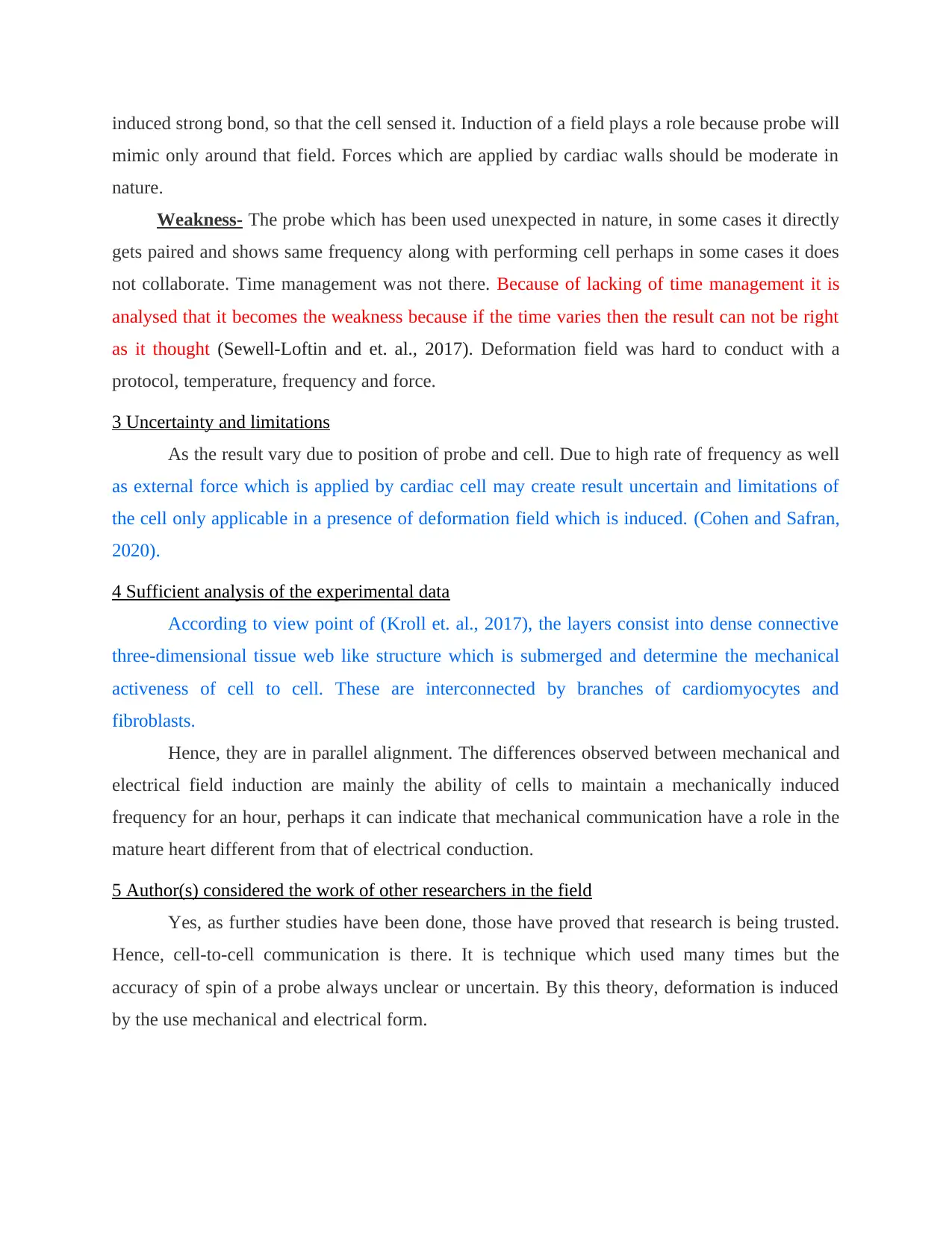
induced strong bond, so that the cell sensed it. Induction of a field plays a role because probe will
mimic only around that field. Forces which are applied by cardiac walls should be moderate in
nature.
Weakness- The probe which has been used unexpected in nature, in some cases it directly
gets paired and shows same frequency along with performing cell perhaps in some cases it does
not collaborate. Time management was not there. Because of lacking of time management it is
analysed that it becomes the weakness because if the time varies then the result can not be right
as it thought (Sewell-Loftin and et. al., 2017). Deformation field was hard to conduct with a
protocol, temperature, frequency and force.
3 Uncertainty and limitations
As the result vary due to position of probe and cell. Due to high rate of frequency as well
as external force which is applied by cardiac cell may create result uncertain and limitations of
the cell only applicable in a presence of deformation field which is induced. (Cohen and Safran,
2020).
4 Sufficient analysis of the experimental data
According to view point of (Kroll et. al., 2017), the layers consist into dense connective
three-dimensional tissue web like structure which is submerged and determine the mechanical
activeness of cell to cell. These are interconnected by branches of cardiomyocytes and
fibroblasts.
Hence, they are in parallel alignment. The differences observed between mechanical and
electrical field induction are mainly the ability of cells to maintain a mechanically induced
frequency for an hour, perhaps it can indicate that mechanical communication have a role in the
mature heart different from that of electrical conduction.
5 Author(s) considered the work of other researchers in the field
Yes, as further studies have been done, those have proved that research is being trusted.
Hence, cell-to-cell communication is there. It is technique which used many times but the
accuracy of spin of a probe always unclear or uncertain. By this theory, deformation is induced
by the use mechanical and electrical form.
mimic only around that field. Forces which are applied by cardiac walls should be moderate in
nature.
Weakness- The probe which has been used unexpected in nature, in some cases it directly
gets paired and shows same frequency along with performing cell perhaps in some cases it does
not collaborate. Time management was not there. Because of lacking of time management it is
analysed that it becomes the weakness because if the time varies then the result can not be right
as it thought (Sewell-Loftin and et. al., 2017). Deformation field was hard to conduct with a
protocol, temperature, frequency and force.
3 Uncertainty and limitations
As the result vary due to position of probe and cell. Due to high rate of frequency as well
as external force which is applied by cardiac cell may create result uncertain and limitations of
the cell only applicable in a presence of deformation field which is induced. (Cohen and Safran,
2020).
4 Sufficient analysis of the experimental data
According to view point of (Kroll et. al., 2017), the layers consist into dense connective
three-dimensional tissue web like structure which is submerged and determine the mechanical
activeness of cell to cell. These are interconnected by branches of cardiomyocytes and
fibroblasts.
Hence, they are in parallel alignment. The differences observed between mechanical and
electrical field induction are mainly the ability of cells to maintain a mechanically induced
frequency for an hour, perhaps it can indicate that mechanical communication have a role in the
mature heart different from that of electrical conduction.
5 Author(s) considered the work of other researchers in the field
Yes, as further studies have been done, those have proved that research is being trusted.
Hence, cell-to-cell communication is there. It is technique which used many times but the
accuracy of spin of a probe always unclear or uncertain. By this theory, deformation is induced
by the use mechanical and electrical form.
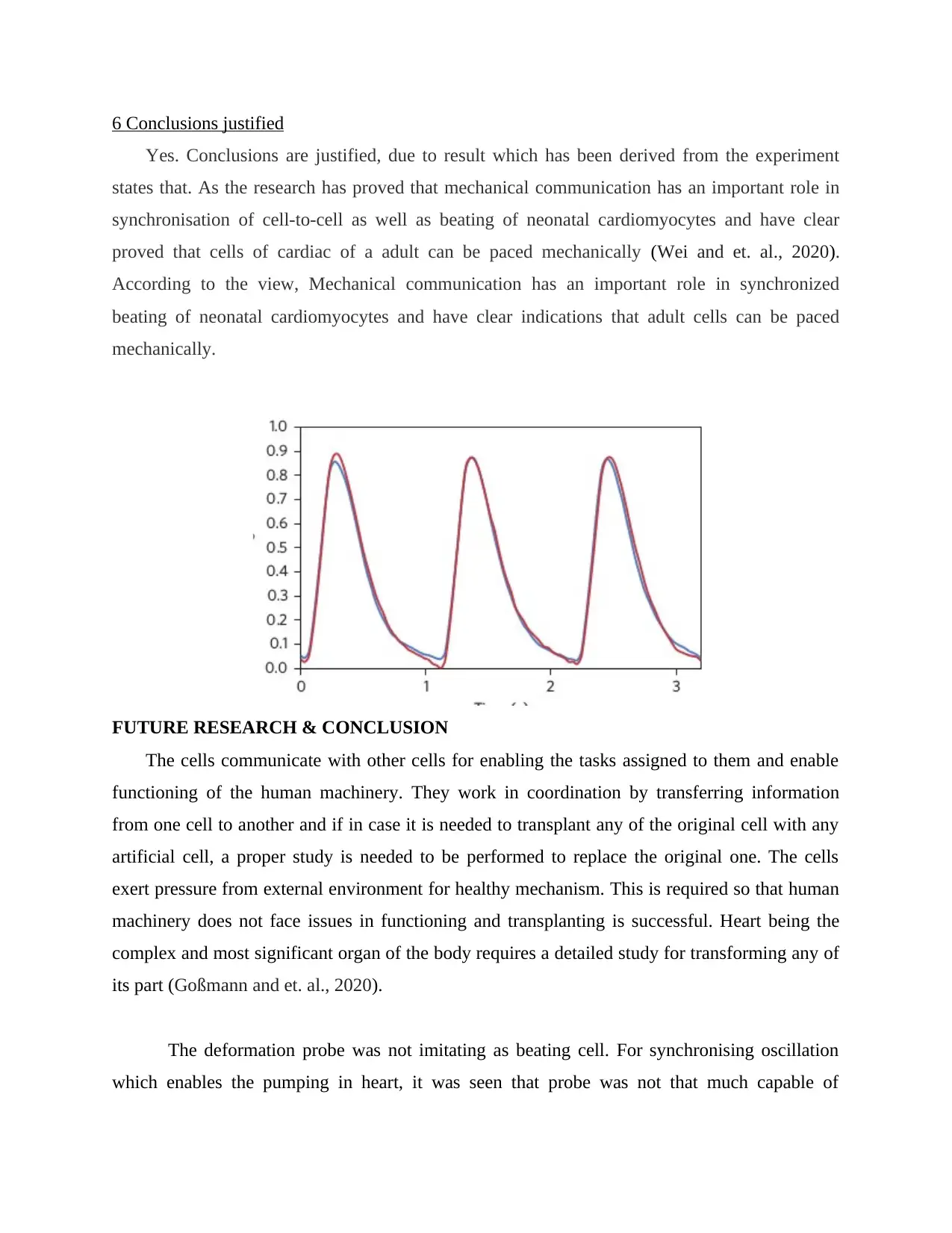
6 Conclusions justified
Yes. Conclusions are justified, due to result which has been derived from the experiment
states that. As the research has proved that mechanical communication has an important role in
synchronisation of cell-to-cell as well as beating of neonatal cardiomyocytes and have clear
proved that cells of cardiac of a adult can be paced mechanically (Wei and et. al., 2020).
According to the view, Mechanical communication has an important role in synchronized
beating of neonatal cardiomyocytes and have clear indications that adult cells can be paced
mechanically.
FUTURE RESEARCH & CONCLUSION
The cells communicate with other cells for enabling the tasks assigned to them and enable
functioning of the human machinery. They work in coordination by transferring information
from one cell to another and if in case it is needed to transplant any of the original cell with any
artificial cell, a proper study is needed to be performed to replace the original one. The cells
exert pressure from external environment for healthy mechanism. This is required so that human
machinery does not face issues in functioning and transplanting is successful. Heart being the
complex and most significant organ of the body requires a detailed study for transforming any of
its part (Goßmann and et. al., 2020).
The deformation probe was not imitating as beating cell. For synchronising oscillation
which enables the pumping in heart, it was seen that probe was not that much capable of
Yes. Conclusions are justified, due to result which has been derived from the experiment
states that. As the research has proved that mechanical communication has an important role in
synchronisation of cell-to-cell as well as beating of neonatal cardiomyocytes and have clear
proved that cells of cardiac of a adult can be paced mechanically (Wei and et. al., 2020).
According to the view, Mechanical communication has an important role in synchronized
beating of neonatal cardiomyocytes and have clear indications that adult cells can be paced
mechanically.
FUTURE RESEARCH & CONCLUSION
The cells communicate with other cells for enabling the tasks assigned to them and enable
functioning of the human machinery. They work in coordination by transferring information
from one cell to another and if in case it is needed to transplant any of the original cell with any
artificial cell, a proper study is needed to be performed to replace the original one. The cells
exert pressure from external environment for healthy mechanism. This is required so that human
machinery does not face issues in functioning and transplanting is successful. Heart being the
complex and most significant organ of the body requires a detailed study for transforming any of
its part (Goßmann and et. al., 2020).
The deformation probe was not imitating as beating cell. For synchronising oscillation
which enables the pumping in heart, it was seen that probe was not that much capable of
⊘ This is a preview!⊘
Do you want full access?
Subscribe today to unlock all pages.

Trusted by 1+ million students worldwide
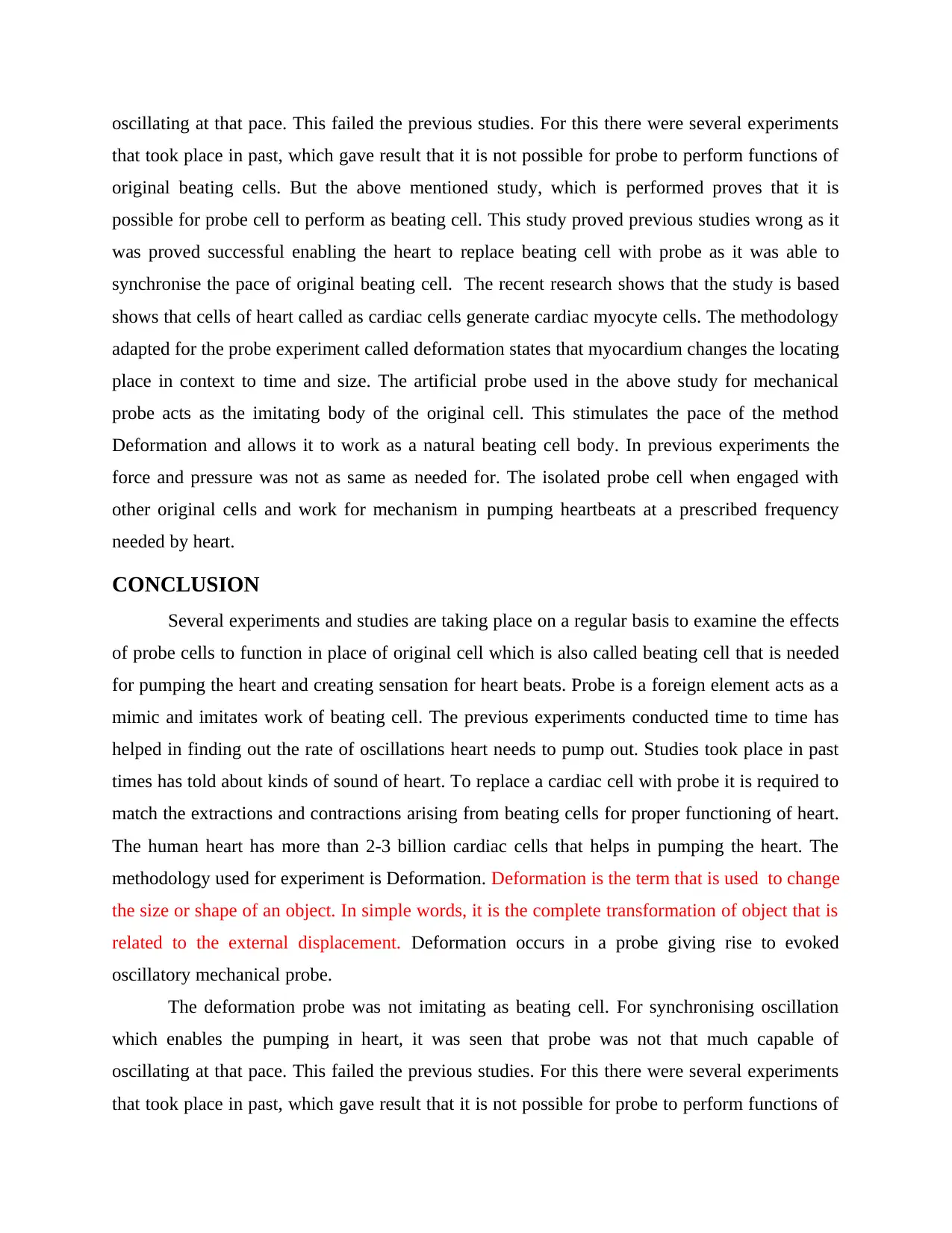
oscillating at that pace. This failed the previous studies. For this there were several experiments
that took place in past, which gave result that it is not possible for probe to perform functions of
original beating cells. But the above mentioned study, which is performed proves that it is
possible for probe cell to perform as beating cell. This study proved previous studies wrong as it
was proved successful enabling the heart to replace beating cell with probe as it was able to
synchronise the pace of original beating cell. The recent research shows that the study is based
shows that cells of heart called as cardiac cells generate cardiac myocyte cells. The methodology
adapted for the probe experiment called deformation states that myocardium changes the locating
place in context to time and size. The artificial probe used in the above study for mechanical
probe acts as the imitating body of the original cell. This stimulates the pace of the method
Deformation and allows it to work as a natural beating cell body. In previous experiments the
force and pressure was not as same as needed for. The isolated probe cell when engaged with
other original cells and work for mechanism in pumping heartbeats at a prescribed frequency
needed by heart.
CONCLUSION
Several experiments and studies are taking place on a regular basis to examine the effects
of probe cells to function in place of original cell which is also called beating cell that is needed
for pumping the heart and creating sensation for heart beats. Probe is a foreign element acts as a
mimic and imitates work of beating cell. The previous experiments conducted time to time has
helped in finding out the rate of oscillations heart needs to pump out. Studies took place in past
times has told about kinds of sound of heart. To replace a cardiac cell with probe it is required to
match the extractions and contractions arising from beating cells for proper functioning of heart.
The human heart has more than 2-3 billion cardiac cells that helps in pumping the heart. The
methodology used for experiment is Deformation. Deformation is the term that is used to change
the size or shape of an object. In simple words, it is the complete transformation of object that is
related to the external displacement. Deformation occurs in a probe giving rise to evoked
oscillatory mechanical probe.
The deformation probe was not imitating as beating cell. For synchronising oscillation
which enables the pumping in heart, it was seen that probe was not that much capable of
oscillating at that pace. This failed the previous studies. For this there were several experiments
that took place in past, which gave result that it is not possible for probe to perform functions of
that took place in past, which gave result that it is not possible for probe to perform functions of
original beating cells. But the above mentioned study, which is performed proves that it is
possible for probe cell to perform as beating cell. This study proved previous studies wrong as it
was proved successful enabling the heart to replace beating cell with probe as it was able to
synchronise the pace of original beating cell. The recent research shows that the study is based
shows that cells of heart called as cardiac cells generate cardiac myocyte cells. The methodology
adapted for the probe experiment called deformation states that myocardium changes the locating
place in context to time and size. The artificial probe used in the above study for mechanical
probe acts as the imitating body of the original cell. This stimulates the pace of the method
Deformation and allows it to work as a natural beating cell body. In previous experiments the
force and pressure was not as same as needed for. The isolated probe cell when engaged with
other original cells and work for mechanism in pumping heartbeats at a prescribed frequency
needed by heart.
CONCLUSION
Several experiments and studies are taking place on a regular basis to examine the effects
of probe cells to function in place of original cell which is also called beating cell that is needed
for pumping the heart and creating sensation for heart beats. Probe is a foreign element acts as a
mimic and imitates work of beating cell. The previous experiments conducted time to time has
helped in finding out the rate of oscillations heart needs to pump out. Studies took place in past
times has told about kinds of sound of heart. To replace a cardiac cell with probe it is required to
match the extractions and contractions arising from beating cells for proper functioning of heart.
The human heart has more than 2-3 billion cardiac cells that helps in pumping the heart. The
methodology used for experiment is Deformation. Deformation is the term that is used to change
the size or shape of an object. In simple words, it is the complete transformation of object that is
related to the external displacement. Deformation occurs in a probe giving rise to evoked
oscillatory mechanical probe.
The deformation probe was not imitating as beating cell. For synchronising oscillation
which enables the pumping in heart, it was seen that probe was not that much capable of
oscillating at that pace. This failed the previous studies. For this there were several experiments
that took place in past, which gave result that it is not possible for probe to perform functions of
Paraphrase This Document
Need a fresh take? Get an instant paraphrase of this document with our AI Paraphraser
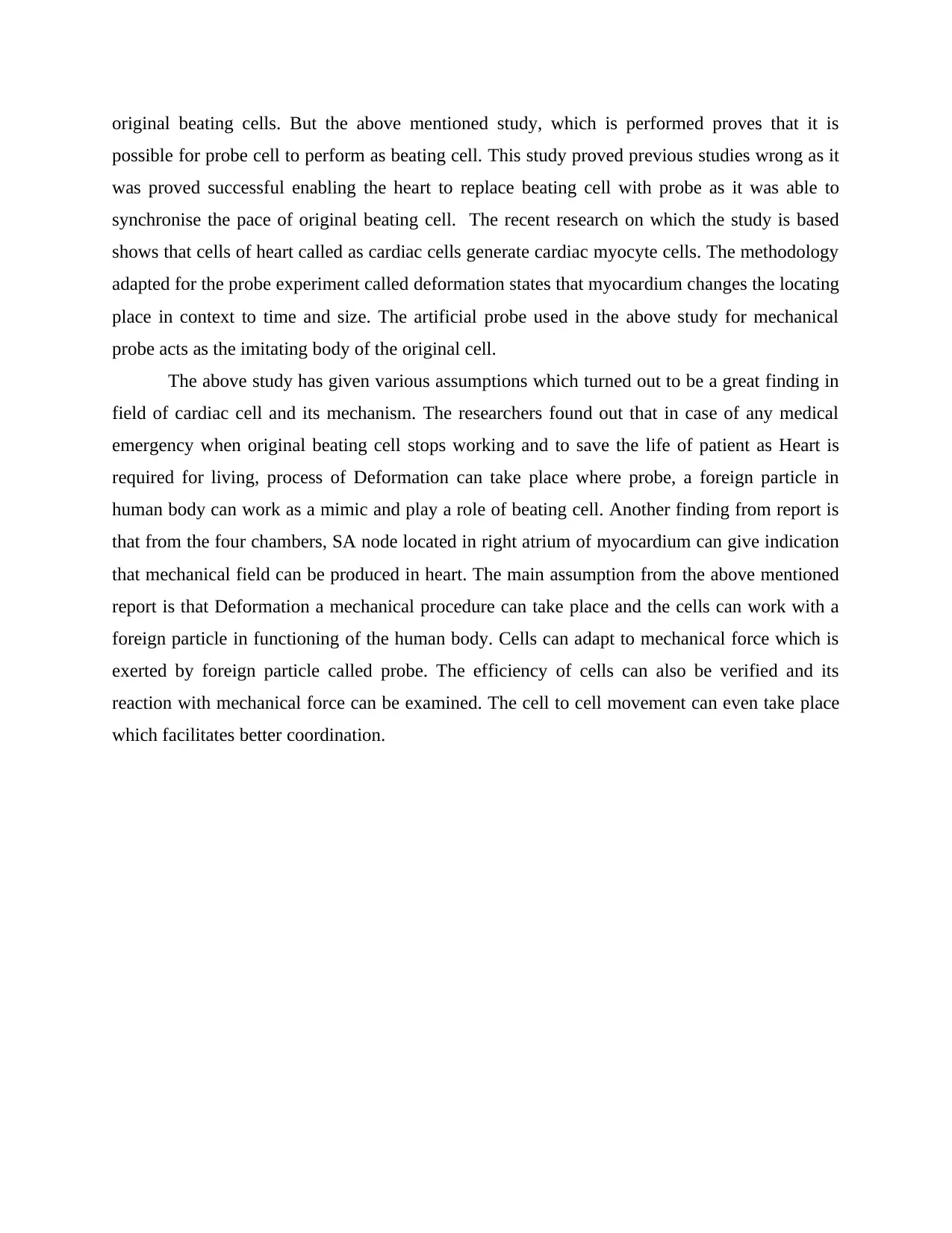
original beating cells. But the above mentioned study, which is performed proves that it is
possible for probe cell to perform as beating cell. This study proved previous studies wrong as it
was proved successful enabling the heart to replace beating cell with probe as it was able to
synchronise the pace of original beating cell. The recent research on which the study is based
shows that cells of heart called as cardiac cells generate cardiac myocyte cells. The methodology
adapted for the probe experiment called deformation states that myocardium changes the locating
place in context to time and size. The artificial probe used in the above study for mechanical
probe acts as the imitating body of the original cell.
The above study has given various assumptions which turned out to be a great finding in
field of cardiac cell and its mechanism. The researchers found out that in case of any medical
emergency when original beating cell stops working and to save the life of patient as Heart is
required for living, process of Deformation can take place where probe, a foreign particle in
human body can work as a mimic and play a role of beating cell. Another finding from report is
that from the four chambers, SA node located in right atrium of myocardium can give indication
that mechanical field can be produced in heart. The main assumption from the above mentioned
report is that Deformation a mechanical procedure can take place and the cells can work with a
foreign particle in functioning of the human body. Cells can adapt to mechanical force which is
exerted by foreign particle called probe. The efficiency of cells can also be verified and its
reaction with mechanical force can be examined. The cell to cell movement can even take place
which facilitates better coordination.
possible for probe cell to perform as beating cell. This study proved previous studies wrong as it
was proved successful enabling the heart to replace beating cell with probe as it was able to
synchronise the pace of original beating cell. The recent research on which the study is based
shows that cells of heart called as cardiac cells generate cardiac myocyte cells. The methodology
adapted for the probe experiment called deformation states that myocardium changes the locating
place in context to time and size. The artificial probe used in the above study for mechanical
probe acts as the imitating body of the original cell.
The above study has given various assumptions which turned out to be a great finding in
field of cardiac cell and its mechanism. The researchers found out that in case of any medical
emergency when original beating cell stops working and to save the life of patient as Heart is
required for living, process of Deformation can take place where probe, a foreign particle in
human body can work as a mimic and play a role of beating cell. Another finding from report is
that from the four chambers, SA node located in right atrium of myocardium can give indication
that mechanical field can be produced in heart. The main assumption from the above mentioned
report is that Deformation a mechanical procedure can take place and the cells can work with a
foreign particle in functioning of the human body. Cells can adapt to mechanical force which is
exerted by foreign particle called probe. The efficiency of cells can also be verified and its
reaction with mechanical force can be examined. The cell to cell movement can even take place
which facilitates better coordination.
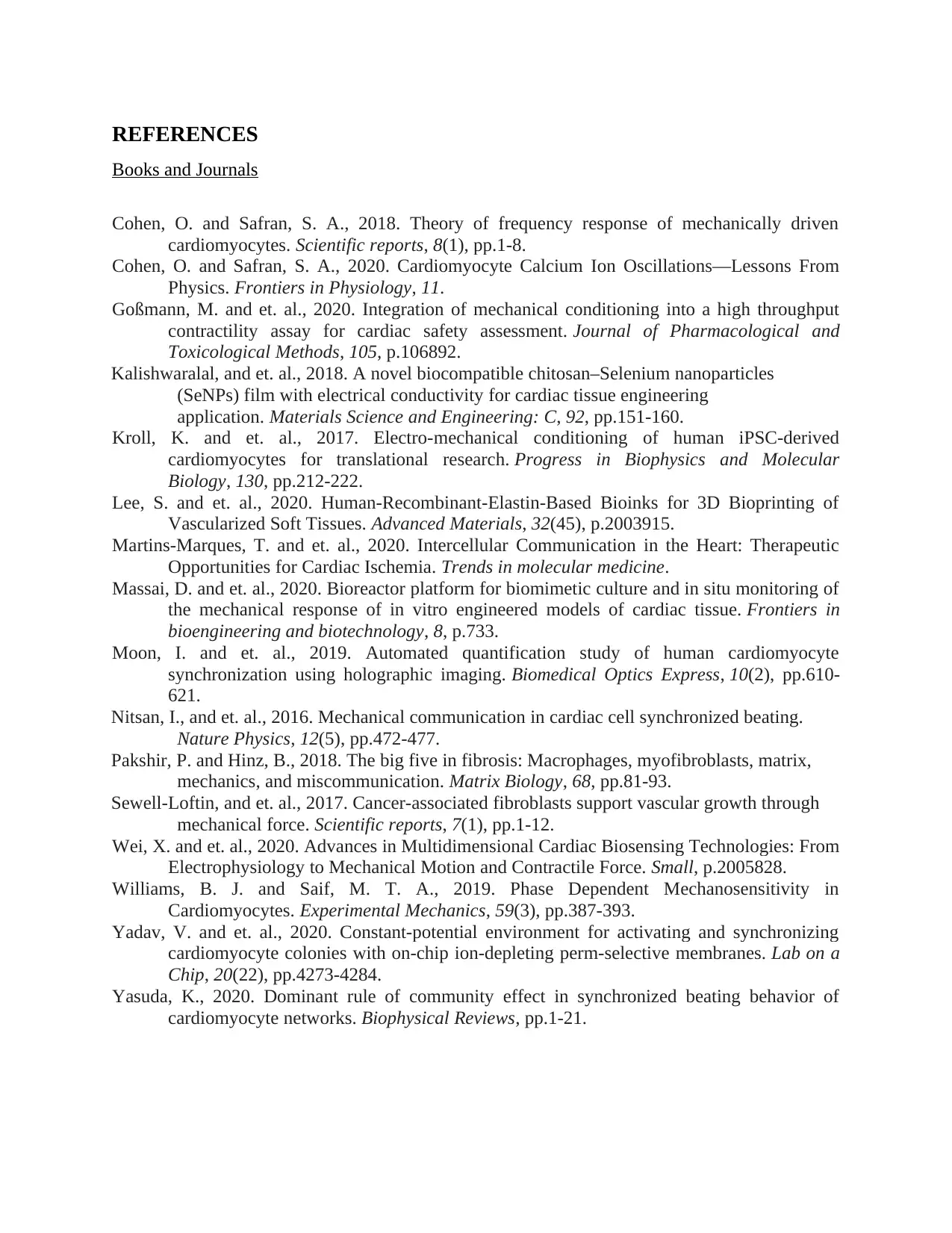
REFERENCES
Books and Journals
Cohen, O. and Safran, S. A., 2018. Theory of frequency response of mechanically driven
cardiomyocytes. Scientific reports, 8(1), pp.1-8.
Cohen, O. and Safran, S. A., 2020. Cardiomyocyte Calcium Ion Oscillations—Lessons From
Physics. Frontiers in Physiology, 11.
Goßmann, M. and et. al., 2020. Integration of mechanical conditioning into a high throughput
contractility assay for cardiac safety assessment. Journal of Pharmacological and
Toxicological Methods, 105, p.106892.
Kalishwaralal, and et. al., 2018. A novel biocompatible chitosan–Selenium nanoparticles
(SeNPs) film with electrical conductivity for cardiac tissue engineering
application. Materials Science and Engineering: C, 92, pp.151-160.
Kroll, K. and et. al., 2017. Electro-mechanical conditioning of human iPSC-derived
cardiomyocytes for translational research. Progress in Biophysics and Molecular
Biology, 130, pp.212-222.
Lee, S. and et. al., 2020. Human‐Recombinant‐Elastin‐Based Bioinks for 3D Bioprinting of
Vascularized Soft Tissues. Advanced Materials, 32(45), p.2003915.
Martins-Marques, T. and et. al., 2020. Intercellular Communication in the Heart: Therapeutic
Opportunities for Cardiac Ischemia. Trends in molecular medicine.
Massai, D. and et. al., 2020. Bioreactor platform for biomimetic culture and in situ monitoring of
the mechanical response of in vitro engineered models of cardiac tissue. Frontiers in
bioengineering and biotechnology, 8, p.733.
Moon, I. and et. al., 2019. Automated quantification study of human cardiomyocyte
synchronization using holographic imaging. Biomedical Optics Express, 10(2), pp.610-
621.
Nitsan, I., and et. al., 2016. Mechanical communication in cardiac cell synchronized beating.
Nature Physics, 12(5), pp.472-477.
Pakshir, P. and Hinz, B., 2018. The big five in fibrosis: Macrophages, myofibroblasts, matrix,
mechanics, and miscommunication. Matrix Biology, 68, pp.81-93.
Sewell-Loftin, and et. al., 2017. Cancer-associated fibroblasts support vascular growth through
mechanical force. Scientific reports, 7(1), pp.1-12.
Wei, X. and et. al., 2020. Advances in Multidimensional Cardiac Biosensing Technologies: From
Electrophysiology to Mechanical Motion and Contractile Force. Small, p.2005828.
Williams, B. J. and Saif, M. T. A., 2019. Phase Dependent Mechanosensitivity in
Cardiomyocytes. Experimental Mechanics, 59(3), pp.387-393.
Yadav, V. and et. al., 2020. Constant-potential environment for activating and synchronizing
cardiomyocyte colonies with on-chip ion-depleting perm-selective membranes. Lab on a
Chip, 20(22), pp.4273-4284.
Yasuda, K., 2020. Dominant rule of community effect in synchronized beating behavior of
cardiomyocyte networks. Biophysical Reviews, pp.1-21.
Books and Journals
Cohen, O. and Safran, S. A., 2018. Theory of frequency response of mechanically driven
cardiomyocytes. Scientific reports, 8(1), pp.1-8.
Cohen, O. and Safran, S. A., 2020. Cardiomyocyte Calcium Ion Oscillations—Lessons From
Physics. Frontiers in Physiology, 11.
Goßmann, M. and et. al., 2020. Integration of mechanical conditioning into a high throughput
contractility assay for cardiac safety assessment. Journal of Pharmacological and
Toxicological Methods, 105, p.106892.
Kalishwaralal, and et. al., 2018. A novel biocompatible chitosan–Selenium nanoparticles
(SeNPs) film with electrical conductivity for cardiac tissue engineering
application. Materials Science and Engineering: C, 92, pp.151-160.
Kroll, K. and et. al., 2017. Electro-mechanical conditioning of human iPSC-derived
cardiomyocytes for translational research. Progress in Biophysics and Molecular
Biology, 130, pp.212-222.
Lee, S. and et. al., 2020. Human‐Recombinant‐Elastin‐Based Bioinks for 3D Bioprinting of
Vascularized Soft Tissues. Advanced Materials, 32(45), p.2003915.
Martins-Marques, T. and et. al., 2020. Intercellular Communication in the Heart: Therapeutic
Opportunities for Cardiac Ischemia. Trends in molecular medicine.
Massai, D. and et. al., 2020. Bioreactor platform for biomimetic culture and in situ monitoring of
the mechanical response of in vitro engineered models of cardiac tissue. Frontiers in
bioengineering and biotechnology, 8, p.733.
Moon, I. and et. al., 2019. Automated quantification study of human cardiomyocyte
synchronization using holographic imaging. Biomedical Optics Express, 10(2), pp.610-
621.
Nitsan, I., and et. al., 2016. Mechanical communication in cardiac cell synchronized beating.
Nature Physics, 12(5), pp.472-477.
Pakshir, P. and Hinz, B., 2018. The big five in fibrosis: Macrophages, myofibroblasts, matrix,
mechanics, and miscommunication. Matrix Biology, 68, pp.81-93.
Sewell-Loftin, and et. al., 2017. Cancer-associated fibroblasts support vascular growth through
mechanical force. Scientific reports, 7(1), pp.1-12.
Wei, X. and et. al., 2020. Advances in Multidimensional Cardiac Biosensing Technologies: From
Electrophysiology to Mechanical Motion and Contractile Force. Small, p.2005828.
Williams, B. J. and Saif, M. T. A., 2019. Phase Dependent Mechanosensitivity in
Cardiomyocytes. Experimental Mechanics, 59(3), pp.387-393.
Yadav, V. and et. al., 2020. Constant-potential environment for activating and synchronizing
cardiomyocyte colonies with on-chip ion-depleting perm-selective membranes. Lab on a
Chip, 20(22), pp.4273-4284.
Yasuda, K., 2020. Dominant rule of community effect in synchronized beating behavior of
cardiomyocyte networks. Biophysical Reviews, pp.1-21.
⊘ This is a preview!⊘
Do you want full access?
Subscribe today to unlock all pages.

Trusted by 1+ million students worldwide
1 out of 9
Related Documents
Your All-in-One AI-Powered Toolkit for Academic Success.
+13062052269
info@desklib.com
Available 24*7 on WhatsApp / Email
![[object Object]](/_next/static/media/star-bottom.7253800d.svg)
Unlock your academic potential
Copyright © 2020–2025 A2Z Services. All Rights Reserved. Developed and managed by ZUCOL.





